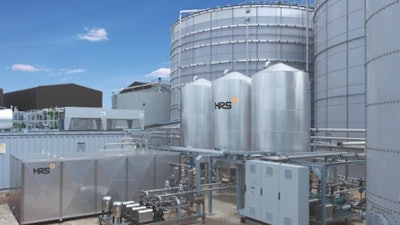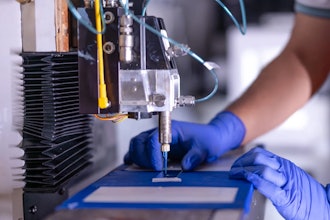
Industrial applications have numerous requirements for heat exchangers and thermal transfer. From compressor and engine cooling to regulating transformer temperatures, recovering heat from various processes or the treatment of effluent, digestate and other waste streams, industrial heat exchangers often have to deal with complex or high-fouling materials in challenging operating environments. Understanding exactly what you want your heat exchanger to achieve, and the nature of the material/s you will be cooling (or heating) is vital in order to specify the correct equipment which will perform well for years to come, and to avoid costly mistakes: with such a variety of applications possible, it’s important that you select the right heat exchanger for your individual requirements.
Picking the right type of heat exchanger for your process
There are a number of types of heat exchanger on the market: plate, tubular, corrugated tube, scraped surface, etc. Each type is suited to a particular application, so think carefully about your process, including the nature of the material/s to be heated or cooled, the objective of the process (such as pre-heating or pasteurization) and any restrictions of the environment where the heat exchanger is to be used. The key to efficient heat transfer is the difference in temperature between the two substances, which are usually but not always fluids. With a smooth tubular heat exchanger, the temperature of two simple fluids changes as they pass through the heat exchanger. However, the smooth flow within the material tube means that anything other than simple Newtonian fluids may not be treated efficiently.
One way to overcome this is to use corrugated tube or scraped surface heat exchangers which are suitable for fluids and materials with complex properties, such as viscous and non-Newtonian fluids, or for materials containing particles or sediment. You should therefore always be mindful of the material to be processed before selecting your heat exchanger and it’s a good idea to seek professional advice from manufacturers and their agents, to help with the selection process.
One important consideration is the way in which materials flow through the heat exchanger, and the design need to allow for the resistance to heat flow which occurs in the various ‘layers’ that form a barrier between the two fluids on either side. There are effectively five such layers:
The inside ‘boundary layer’ formed by the fluid flowing in close contact with the inside surface of the tube.
The fouling layer formed by deposition of solids or semi-solids on the inside surface of the tube (this layer may or may not be present, but is particularly found with digestate).
The thickness of the tube wall and the material used, which will govern the resistance to heat flow though the tube itself.
The fouling layer formed by deposition of solids or semi-solids on the outside surface of the tube (which may or may not be present).
The outside ‘boundary layer’ formed by the fluid flowing in close contact with the outside surface of the tube.
The values for numbers 2 and 4 can usually be based on experience, while the designer of the heat exchanger will select the tube size, thickness and materials to suit the application. The resistance to heat flow resulting from numbers 1 and 5 (known as the partial heat transfer coefficients) depends both on the nature of the fluids and the geometry of the heat transfer surfaces, and are determined by a combination of experience and mathematics.
The importance of turbulence
One way to prevent the build-up of these layers is to increase the speed at which the fluid passes through the heat exchanger so that turbulence is formed and the boundary layer breaks away from the surface of the tube. This is the point at which so-called laminar flow (with the fluid passing through in smooth layers, where the innermost layer flows at a higher rate than the outermost) becomes turbulent flow (where fluid does not flow in smooth layers but is mixed or agitated as it flows).
The speed at which this occurs is influenced by many different factors, but in order to quantify it for the purpose of specifying heat exchangers, the Reynolds number (Re) is used. This is determined by the diameter of the tube, the mass velocity of the fluid and its viscosity. Reynolds numbers of less than 2,100 describe laminar flows, while numbers above 10,000 describe full turbulent flow. Between the two values is an area of uncertainty called the transitional zone, where we see a general transition from full laminar to full turbulent flow. In practice, engineers try to provide solutions outside of this zone as much as possible. Tube deformation such as corrugation helps to increase the heat transfer performance once the fluid/s have entered the turbulent flow area (Re > 2,100). This is the main reason for using corrugated tube heat exchangers.
When corrugations are not enough
For many materials the turbulent flow created in corrugated tube heat exchangers is sufficient to prevent the build-up of boundary layers and maintain the efficiency of the heat transfer. However, for the most challenging situations, such as effluents, digestate from anaerobic digestion, very viscous materials or those containing particles, further agitation or the physical removal of deposits from inside the heat exchanger tubes is required.
There are two main types of scraped-surface heat exchanger. The simplest use a helical screw mechanism or scraper rod within the tube. In some cases velocities of 300 rpm can be achieved, providing high levels of shear and mixing at the heat transfer surface which dramatically increases heat transfer rates. This makes such a system particularly suitable for challenging heat transfer applications, such as those where the product has the potential to crystallize during processing or where aeration is required. For more challenging materials, both a helical mixing spiral (which reduces the pressure drop in the tube) and a series of scraper blades are combined on the scraper rod (as in the HRS R Series). Together these provide a continuous scraping action which mixes highly viscous products and reduces fouling. The unique design enables high viscosity products to be pumped with reduced back pressure and lower energy use, in a compact unit which features a much smaller footprint than traditional heat exchangers for similar applications. Furthermore, thanks to its helical spiral, in many applications the R Series can be run in reverse, enabling valuable products to be recovered before routine cleaning or product change-over without the need for additional pigging or flushing systems.
Rotary scrapers are not the only solution, particularly where the material being cooled or heated has a high fouling potential (therefore limiting heat transfer), but which also needs delicate handling to preserve fragile product integrity. The solution (as used in the HRS Unicus Series) is a patented stainless steel scraping mechanism which is hydraulically moved back and forth within each interior tube. This movement performs two key functions. Firstly, it minimizes potential fouling of the product by keeping the tube wall clean. Secondly, the movement creates turbulence within the material. Both of these actions help to increase heat transfer rates and together, they create a highly efficient heat transfer process ideal for viscous and high fouling materials.
Another benefit is the fact that the separate hydraulic action means that the speed of the scrapers (which are available in a number of different designs) is highly controllable and can be optimized for the product being processed. This means that materials which are susceptible to shear stress or pressure damage can be handled gently to prevent such damage while still providing high levels of heat transfer.
Making sure you have the right size heat exchanger
Once the correct type of exchanger for the job has been chosen, you then need to make sure that the model supplied is correctly sized, so that it offers the right amount of heat transfer for the material/s being treated while providing the required throughput. The heat exchanger must have a large enough heat transfer area for the specified fluids and their specified inlet and outlet temperatures. Most calculations should also factor in other variables, such as whether the heat exchanger operates using counter-flow or parallel flow.
State of the art calculations
As with any kind of science, the mathematics and understanding of thermal dynamics is continuing to evolve and improve. However, much of the literature commonly used to build calculations and model heat exchanger performance can be up to 80 years old, and does not always reflect the most recent science. Also, while there is scientific literature for the behavior of fluids in smooth and corrugated tubes, there is little published data on scraped surface heat exchangers. We recently produced a new state of the art software program which we use to calculate the necessary size of our heat exchangers. Based on our experience and the most recent scientific data available, the new model is already producing some interesting results and giving new insights into how to design tubular and scraped surface heat exchangers which provide the very best levels of performance.
Matt Hale is the international sales and marketing director of HRS Heat Exchangers.






















